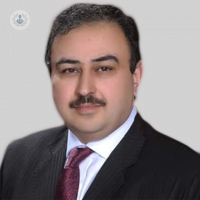Bunions and MIS surgery: how they’ve changed
Written in association with:Relatively common, everyone either has experienced bunions or knows someone who has. They form slowly over time and can impact a person’s day to day life. To tell us more, experienced consultant orthopaedic and trauma surgeon Mr Turab Syed has provided us this enlightening article.

What is MIS surgery?
MIS is short for minimally invasive surgery, which means that one performs surgery through small, mini incisions, which is usually the size of the tip of a ballpoint pen. The orthopaedic procedures carried out by introducing special balls to break the bone and with special instruments to carry out the rest of the surgery which include retractors, etc.
Can MIS surgery be used for bunions, and what are the advantages of MIS surgery?
Yes, MIS surgery has been used for bunions, and it is well-proven for at least 10 to 12 years.
These medical research articles show that there is less post-operative pain with the use of MIS surgical technique and instruments. It makes smaller incisions which is cosmetically better and heals quicker, and the outcomes are as good as open surgery with a higher patient satisfaction score. Also, MIS surgery versus open procedures has shown that there is a reduction in the requirement of use of opioid (narcotic pain killer) after MIS surgery.
What is bunion, or hallux valgus as doctors commonly refer it to?
Hallux valgus is the medical name for bunions. Hallux means big toe, and valgus means that it is going towards the outer side. As in bunion, the big toe bone starts moving towards the outside so the part of the big toe where there are the nail and the bone before it starts turning toward the lesser toe and the big toe starts becoming prominent on the inside. Bunion is more common in females, though it is found across all age groups. In women, it is found up to 40 per cent as opposed to 20 per cent in men, and its prevalence (the presence of a particular condition) increases as one becomes more mature or older.
What is known about bunions and what research has been done?
There is postulation that high prevalence rate among women may be due to footwear that is either poor or less forgiving, resulting in earlier and more frequent presentation. This was found in the Japanese population before the second World War when they did not use to wear closed-fitting shoes, and after the second World War when they started to wear closed-fitting shoes due to American influence. Having taken into account this observation, there is a tribe in Africa where they are found to have significant hallux valgus and they have never worn any footwear (in Kenya, Solomon Islands, Belgian Congo).
I think this is a good to place to mention that physicians in France started to refer to the development of the bunion deformities as early as the eighteenth century. Before that time, the common footwear was a Draco-Roman style, flat-soled sandal. Similarly, studies have shown that there is very low incidence of hallux valgus in Nigerian youth, in a typical un-shoed population.
As far back as 1956, Johnston reported after an in-depth genetic history of subjects with bunion that it had an autosomal dominant trait with incomplete penetrance. This means that the condition would appear even if only one gene is present rather than having both genes from both parents. Other studies, like by pique-vital et al, looking at 250 patients with bunions going through a three-generation pedigary, the ratio was male:female 1:15. 90 per cent of the subjects had at least one other relative with a bunion. 70 per cent of subjects said at least three relatives with bunion involvement.
How can MIS surgery treat bunions?
MIS surgery can help because of the reasons stated above to have a quicker recovery and achieve the same outcome as open surgery. Over the time, the MIS surgery has improved and now during the third generation minimally invasive surgery where a modified chevron-akin technique with internal fixation to add extra stability is used. While carrying out the surgery, X-rays are used with a specially designed bar to carry out the osteotomy and fix it through specially designed minimally invasive screws. Because the incision is smaller, the risk of injury to nerve, blood vessel, and tendon is lower, as well. An anatomical study of the minimally invasive surgical correction of bunions found that there was no great incidence of nerve injury or blood vessel damage and there was no tendon injury compared to open surgery.
Approximately 50,000 procedures like this have been carried out in the world and the instrumentation from the first generation to the third generation has improved taking into account the challenges faced in the first- and second-generation MIS surgery. There are roughly 34 papers available in medical literature regarding this.
Similarly, those people who have got a really big toe because of the arthritis, where open cheilectomy was done, can now have MIS cheilectomy.
If you have a bunion or have concerns that you may be prone to getting one, you can schedule a consultation at Mr Syed’s profile.


